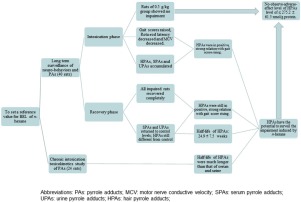当前位置:
X-MOL 学术
›
Neurotoxicology
›
论文详情
Our official English website, www.x-mol.net, welcomes your
feedback! (Note: you will need to create a separate account there.)
No-observed-adverse-effect level of hair pyrrole adducts in chronic n-hexane intoxication in rats.
NeuroToxicology ( IF 3.4 ) Pub Date : 2020-02-08 , DOI: 10.1016/j.neuro.2020.02.002 Xianjie Li 1 , Lulu Jiang 2 , Ting Yu 1 , Ming Li 1 , Qiong Wang 1 , Zhidan Liu 1 , Keqin Xie 1
NeuroToxicology ( IF 3.4 ) Pub Date : 2020-02-08 , DOI: 10.1016/j.neuro.2020.02.002 Xianjie Li 1 , Lulu Jiang 2 , Ting Yu 1 , Ming Li 1 , Qiong Wang 1 , Zhidan Liu 1 , Keqin Xie 1
Affiliation

|
n-Hexane has been reported to induce serious peripheral neuropathy in workers. Pyrrole adducts are the unique reaction products of n-hexane in organisms and have been demonstrated to be critical to n-hexane neuropathy. Our previous studies have demonstrated that pyrrole adducts could accumulate in hair and showed high correlation with neuropathy at the end of experiments in rat models. In the present study, we examined the time course of hair pyrrole adducts and behavioral changes in rats exposed to different dosages of n-hexane in both treatment (24 weeks) and recovery phases. Our results showed: 1. After treatment, 1.0, 2.0, and 4.0 g/kg dosage groups all lost weight, but the 0.5 g/kg dosage group showed no impairment; after recovery, all impaired rats regained weight. 2. After treatment, 1.0, 2.0, and 4.0 g/kg dosage groups all showed a rise in gait scores, decreased rotarod latency, and decreased motor nerve conduction velocity, whereas the 0.5 g/kg dosage group showed no impairment; after recovery, all impaired rats were completely rehabilitated. 3. After treatment, levels of pyrrole adducts in serum, urine, and hair of experimental groups increased; after recovery, serum and urine pyrrole adducts showed no difference from the control (P > 0.05), whereas hair pyrrole adducts were significantly different from the control (P < 0.01). 4. The half-lives of serum and urine pyrrole adducts were 47.8-78.0 h and 42.7-52.9 h, while the half-life of hair pyrrole adducts was 14-24 weeks. 5. During treatment and recovery, levels of serum, urine, and hair pyrrole adducts showed high correlation with gait scores (P < 0.01), and hair pyrrole adducts had the largest partial correlation coefficient. In conclusion, hair pyrrole adducts could serve as a stable and reliable biomarker for the prevention of n-hexane intoxication. Furthermore, the no-observed-adverse-effect level of hair pyrrole adducts in rats is 275.2 ± 61.5 nmol/g protein. Further studies are required for the definition of the biological exposure limit in humans.
中文翻译:

在大鼠慢性正己烷中毒中,未观察到毛吡咯加合物的不良影响水平。
据报道,正己烷会引起工人严重的周围神经病变。吡咯加合物是有机物中正己烷的独特反应产物,并已证明对正己烷神经病至关重要。我们以前的研究表明,吡咯加合物可能在头发中积累,并在大鼠模型的实验结束时显示出与神经病变的高度相关性。在本研究中,我们研究了在治疗(24周)和恢复阶段暴露于不同剂量正己烷的大鼠中头发吡咯加合物的时间进程和行为变化。我们的结果表明:1.治疗后,1.0、2.0和4.0 g / kg剂量组均体重减轻,但0.5 g / kg剂量组无损伤;恢复后,所有受损的大鼠均恢复了体重。2.治疗后,分别为1.0、2.0和4。0 g / kg剂量组均显示步态得分升高,轮状潜伏期减少,运动神经传导速度降低,而0.5 g / kg剂量组无损伤。恢复后,所有受损的大鼠均完全康复。3.治疗后,实验组血清,尿液和头发中吡咯加合物的含量增加;恢复后,血清和尿液中的吡咯加合物与对照组无差异(P> 0.05),而毛发吡咯的加合物与对照组相比则存在显着差异(P <0.01)。4.血清和尿吡咯加合物的半衰期为47.8-78.0 h和42.7-52.9 h,而头发吡咯加合物的半衰期为14-24周。5.在治疗和恢复过程中,血清,尿液和头发吡咯加合物的水平与步态得分高度相关(P <0.01),毛吡咯加合物的相关系数最大。总之,毛吡咯加合物可作为稳定和可靠的生物标志物,用于预防正己烷中毒。此外,在大鼠中未观察到的毛吡咯加合物的不良反应水平为275.2±61.5 nmol / g蛋白质。定义人体生物暴露极限还需要进一步的研究。
更新日期:2020-02-10
中文翻译:

在大鼠慢性正己烷中毒中,未观察到毛吡咯加合物的不良影响水平。
据报道,正己烷会引起工人严重的周围神经病变。吡咯加合物是有机物中正己烷的独特反应产物,并已证明对正己烷神经病至关重要。我们以前的研究表明,吡咯加合物可能在头发中积累,并在大鼠模型的实验结束时显示出与神经病变的高度相关性。在本研究中,我们研究了在治疗(24周)和恢复阶段暴露于不同剂量正己烷的大鼠中头发吡咯加合物的时间进程和行为变化。我们的结果表明:1.治疗后,1.0、2.0和4.0 g / kg剂量组均体重减轻,但0.5 g / kg剂量组无损伤;恢复后,所有受损的大鼠均恢复了体重。2.治疗后,分别为1.0、2.0和4。0 g / kg剂量组均显示步态得分升高,轮状潜伏期减少,运动神经传导速度降低,而0.5 g / kg剂量组无损伤。恢复后,所有受损的大鼠均完全康复。3.治疗后,实验组血清,尿液和头发中吡咯加合物的含量增加;恢复后,血清和尿液中的吡咯加合物与对照组无差异(P> 0.05),而毛发吡咯的加合物与对照组相比则存在显着差异(P <0.01)。4.血清和尿吡咯加合物的半衰期为47.8-78.0 h和42.7-52.9 h,而头发吡咯加合物的半衰期为14-24周。5.在治疗和恢复过程中,血清,尿液和头发吡咯加合物的水平与步态得分高度相关(P <0.01),毛吡咯加合物的相关系数最大。总之,毛吡咯加合物可作为稳定和可靠的生物标志物,用于预防正己烷中毒。此外,在大鼠中未观察到的毛吡咯加合物的不良反应水平为275.2±61.5 nmol / g蛋白质。定义人体生物暴露极限还需要进一步的研究。











































 京公网安备 11010802027423号
京公网安备 11010802027423号